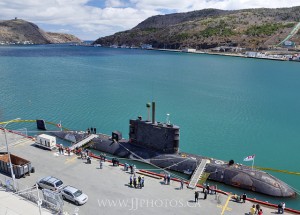Membership for Colombia?
Counter-piracy in the Gulf of Guinea
Perspectives
Predictions and forecasting.
Membership for Colombia?
Counter-piracy in the Gulf of Guinea
Perspectives
By Andrew Chisholm
Canada’s submarine fleet often sparks debate, over its high maintenance costs and over whether Canada needs submarines at all. Going forward, that debate must center on how costs, capabilities, and Canadian interests align with one another.
Canada’s Victoria-class submarine fleet has been controversial since its inception. Most recently, a report by Michael Byers and Stewart Webb argues that the time has come to either phase out the program or commit to a robust discussion of how to replace the fleet. Critics cite a disappointing history of expensive repairs, time lost, and a tragic fire. Supporters insist that the boats provide important capabilities, and Navy planners have sought to get the ball rolling on acquiring new subs sometime after 2020. Going forward, debate over the current fleet and its potential replacement should include all of those elements, but focus on how they align with one another: whether submarines provide the right capabilities at the right price to serve Canada’s national interests.
Costs
The subs were launched in the late 1980s and early 1990s, laid aside by the UK in 1994, purchased by Canada in 1998, and delivered between 2000 and 2004. Canada undertook their first real refit after years sitting in saltwater, ending in significant cost overruns. Tragically, during its cross-Atlantic voyage a fire broke out on HMCS Chicoutimi resulting in the death of a Sailor and deferral of Chicoutimi’s repairs to 2010.
Since 2003, the boats have spent a combined total of 1131 days at sea (less than 33% of the time). HMCS Corner Brook remains in maintenance (to be completed in 2016) begun after she ran aground during exercises in 2011, and despite a recent $209-million refit HMCS Windsor is restricted to operations in Canadian waters until one engine is removed and replaced late this summer.

Nevertheless, the fleet is scheduled to reach “steady state,” (two subs at high readiness, one at standard readiness, and one in refit) with the completion of Chicoutimi’s repairs at the end of 2013. As one retired Admiral says, the fleet may be turning a corner and Canada now able to reap some benefits.
With regard to replacing the fleet, Byers and Webb note the three main options, ranging in cost (depending on capabilities) from $365 million to $950 million per ship. They also note that replacement subs would be new, off-the-shelf (but built in Canada) and unlikely to have similar maintenance problems and costs.
Interests and Capabilities
The Canadian interests for which submarines could be relevant can be divided into three categories: the defense of Canada and North America, support of Canadian expeditionary deployments, and support of Canada’s interest in global maritime stability.
First, regarding the defense of Canada and North America, proponents argue that submarines provide the ability to covertly carry out coastal sovereignty and surveillance patrols, including in the Arctic. But as Byers and Webb point out, in Canadian waters at least, these functions can be performed better (and cheaper) by aircraft and drones, combined with surface-craft for enforcement. Also, the Victoria Class has no under-ice capability, although new subs likely would.
Second, submarines could support certain expeditionary deployments. The current fleet can provide security for other naval platforms, their covert surveillance and intelligence gathering capabilities would be valuable, and they can enhance the activities of special operations forces. New subs could have the capability to hit land targets with guided missiles launched from offshore, as American and British boats did in support of NATO’s Libyan operation in 2011.
Supporting global maritime stability is a key interest for Canada as it relies heavily on sea-borne trade, even with the United States. More broadly, Canada has long worked to entrench and expand global trade, which is heavily sea-reliant. As its government seeks to expand trade relations with Europe, Asia, and Latin America the importance of commercial sea routes, and therefore of global maritime stability, will only increase for Canada.
This is particularly the case in the quintessentially maritime Asia Pacific region where China in particular is driving growth in economic and military power. Byers and Stewart argue that because of its global trading links, including with Canada, China is unlikely to engage in conflict, so investing in submarines based on the slim probability of Canadian engagement in such a conflict may be unwise. But according to Elinor Sloan, “Horizon 2050: A strategic concept for Canada’s navy,” the document presumed to be guiding future naval platform acquisitions, views maritime inter-state competition in the region with concern.
As I outlined in a previous article, territorial disputes, great power strategy, and nationalist emotions in Asia Pacific create a volatile mix. In this environment conventional deterrence and power projection will play an important role, either in maintaining stability or in actual conflict. The potential for a Canadian submarine presence in such Asia Pacific roles was forecast by HMCS Victoria’s participation in the US-led Rim of the Pacific, 2012 exercise.
In this vein, as Commander Craven notes, submarines provide access to areas denied to other forces and serve as a credible deterrent against almost all forces, including other states’ sea-borne power projection platforms. They can also serve in a power projection role, especially around shipping “choke points” and littoral areas. To be sure, surface ships can perform these roles (and others that submarines cannot), but they lack the tactical and psychological advantages of stealthy subs.
Conclusion
Debate concerning Canada’s submarine fleet and its possible renewal will consider many factors, from costs to capabilities and interests. The final decision must be made based on how those factors align with each other. Submarines provide many capabilities, but they are not necessarily the only platforms that do, and may or may not be the most efficient platforms in the doing. I am not qualified to judge whether submarines are the ideal platform for Canada to secure its interests as efficiently as possible, but that discussion of balance must be the center of debate going forward.
Andrew Chisholm is a Junior Research Fellow at the Atlantic Council of Canada. He recently graduated from the University of King’s College with a B.A., Combined Honours, in Political Science and History, and studied Conflict Resolution at the Rothberg International School at Hebrew University in Jerusalem. Andrew focuses his writing on contemporary Canadian foreign, defence, and security policy. His wider interests include sovereignty and governance, international diplomacy, and emerging security threats. Contact: [email protected]
Daniel Drezner is an International Politics professor at Tufts University with an informative and entertaining blog at Foreign Policy. He recently published an article in the journal International Security asking whether “military primacy yields direct economic benefits.”
This is an important issue for seapower advocates, with organizations like the U.S. Navy traditionally claiming that American dominance at sea is part of the bedrock foundation of a smoothly running international economic system. The 2007 Cooperative Strategy for 21st Century Seapower argues that the “maritime domain…carries the lifeblood of a global system that links every country on earth,” and that “United States seapower will be globally postured to secure our homeland and citizens from direct attack and to advance our interests around the world that relies on free transit through increasingly urbanized littoral regions.”
The 2010 Naval Operations Concept similarly envisions U.S. naval forces that “effectively conduct the full range of maritime security operations and are instrumental in building the capacity, proficiency and interoperability of partners and allies that share our aspiration to achieve security throughout the maritime commons.”

Drezner examines three potential ways in which a state’s military primacy could provide tangible benefits:
1. Geoeconomic Favoritism: “Military preeminence” may spur private sector investment both domestically and from abroad, as “all else being equal, a country is far more likely to attract foreign capital if it is secure from foreign invasion.”
2. Geopolitical Favoritism: Weaker states may “provide voluntary economic concessions to the dominant security actor.”
3. The Public Goods Benefit of Military Primacy: Military “primacy facilitates the creation of global public goods” with “a wide range of international relations theorists” claiming “that a liberal hegemon is a necessary and sufficient condition for the creation of an open global economic order.”
The particular potential benefits of U.S. seapower in its current, globally-deployed state would most likely be realized in terms of the “Public Goods Benefit.” The particular hypothesis which Drezner is trying to test here is whether “by acting as a guarantor of the peace in hotspots such as the Middle East and Pacific Rim, the United States keeps the international system humming along-which in turn yields significant benefits to the United States itself.”
In terms of concrete examples of how the U.S. military has secured the global economy by protecting the sea-lanes, Drezner cites naval operations in the Middle East, an area of both political instability and significant economic importance due to the need to securely ship oil out of the region as well as the recent multi-national campaign against Somali pirates. However, he then proceeds to question whether naval or military power can be credited with minimizing energy market disruptions or defeating piracy, pointing out that “world oil markets” can be relatively resilient and are capable of adjusting to severe price changes, and that “improved private security on board” merchant shipping may have been a more important factor in the decreased threat from Somali pirates. With his focus being military power in general, however, he does not provide a detailed discussion of seapower’s role in the global economy other than his brief discussion of oil and piracy.

Drezner claims that if “unipolarity” and military primacy worked as predicted, China should have been “pacified” by the various manifestations of U.S. policy towards the Far East as part of the the 2011 “pivot,” but instead has acted increasingly aggressive towards its neighbors. Unaddressed in this article, yet probably at the top of the list of factors impacting and/or justifying continued U.S. naval hegemony in the Pacific, is the tangible impact of growing Chinese strength afloat. It is often assumed by China-phobes that a China with a strong navy acting assertively in regards to its claims over the surrounding oceans would be bad for the international system (presumably through somehow limiting freedom of navigation in the region), hence justifying continued American military presence in the Pacific. However, there is no empirical evidence to prove that case yet (because it has not happened), and advocates of both sides are forced to rely on hypotheticals. Drezner has asked the right macro-level questions, but it is unclear if there is specific enough data to generate a definitive answer regarding the tangible benefits of specifically American (or Chinese) naval primacy in East Asia.
Drezner concludes that military primacy is an important resource for a Great Power, but that “military preeminence” alone does not produce “significant economic gains.” Although primacy can be an “an important adjunct to the creation of an open global economy and the reduction of militarized disputes and security rivalries,” a hegemon whose economic strength is declining may not be capable of reaping the benefits of the economic system it has established and protected.
While members of the sea services or naval enthusiasts generally embrace the notion that seapower is an important element of protecting the international system and prosperity both at home and abroad as undisputed truth and gospel, the jury is still out on whether military power is always worthwhile in economic terms, and Drezner questions those often reflexive assumptions here. In an era of budget uncertainty, the Navy needs to have good tangible answers to justify its continued existence when these types of questions are asked in the future.
Lieutenant Commander Mark Munson is a Naval Intelligence officer currently serving on the OPNAV staff. He has previously served at Naval Special Warfare Group FOUR, the Office of Naval Intelligence, and onboard USS Essex (LHD 2). The views expressed are solely those of the author and do not reflect the official viewpoints or policies of the Department of Defense or the U.S. Government.
Not that we’re calling you a dummy…
 In his talk at the U.S. Naval Warfare Development Command last Friday, CDR Bryan McGrath (ret.) made some important assertions about the affordability of our Navy in the context of the Federal Budget. At about the five minute point, he describes what he envisions as the ideal Navy to meet the United States’ security needs and proposes that it would cost about $25 Billion more than what we currently spend. He then goes on to place $25 Billion in context:
In his talk at the U.S. Naval Warfare Development Command last Friday, CDR Bryan McGrath (ret.) made some important assertions about the affordability of our Navy in the context of the Federal Budget. At about the five minute point, he describes what he envisions as the ideal Navy to meet the United States’ security needs and proposes that it would cost about $25 Billion more than what we currently spend. He then goes on to place $25 Billion in context:
$25 Billion Dollars is:
“…so don’t tell me we can’t afford a bigger Navy,” commands McGrath. “We can afford it. We choose not to have a bigger Navy.”
If we’re going to talk about government spending, it is important to make sure we’re all reading from the same sheet of music. DoD advocates like CDR McGrath assert that the portion of national treasure we’re willing to invest in Defense is approaching record lows. Defense spending critics suggest that even in spite of cuts, we are throwing more money at DoD than at almost any point in history, to include the heights of the Cold War arms races. They are all correct; whether we are at a low point or a high point in defense spending is entirely subject to the frame of reference. Which reference we choose will invariably be determined by our motives.
Discussions of Defense spending are generally framed in one of three ways:
1. Defense Spending as a Function of Dollars Spent
It’s hard to argue with cold hard cash. The money we spend on Defense has grown at an accelerating rate over the last century:
However convincing this graph is at first glance, you’ll find that only the most hyperbolic of critics of Defense spending will rest their argument on it. It is based on nominal or “actual” dollars spent, which do not account for the erosion of purchasing power that is inflation. We can correct for inflation by selecting a “base year” and then adjusting the dollar amounts at every other point to the purchasing power of an equivalent sum of money in the base year. Using 2014 as the base year, our corrected graph of defense spending looks more like this:
The blue line indicates what Defense spending would have been if the purchasing power of a dollar had always been equal to its 2014 value. While spending has oscillated pretty widely, the overall trend is positive: the price, presumably, of steady growth in things like technological complexity, personnel benefits, veteran health care, and administrative overhead. One major source of contention when framing arguments around inflation-adjusted dollars is exactly which rate of inflation is correct. Economists do not all agree, and DoD claims yet another rate of inflation from the economy at large due to a variety of factors.
2. Defense Spending as a Function of Resource Allocation
We’ve all seen a graph like this:
We can’t even balance the budget, and we’re spending over half of it on the military!? Preposterous!
Are we really, though? Pay attention to the title: this graph shows “Discretionary Spending,” which is that portion of the federal budget that is determined by Congress through an appropriations bill. This is opposed to “Mandatory Spending,” which is the outlay of government funds required by law. If we include Mandatory Spending, allocation of federal spending will look more like this:
Mandatory Spending is effectively made up of entitlement programs. It is important to point out that in the fiscal sense, “entitlement” is not the sense of privilege attributed to Millennials by the previous generations. Entitlement is a technical term which describes expenditures which are not limited by any budget, but instead are a function of the number of people who qualify for them and the expenses incurred by the services promised. Because they don’t need to be re-approved every year, unlike discretionary spending, most entitlement expenditures will grow uncontrollably without a change in the law.
3. Defense Spending as a Function of Economic Output
Described in terms of Gross Domestic Product, or the total economic output of the United States, Defense spending looks something like this:
The graph illustrates a downward trend in economic capacity committed to the military. Most DoD budget people will describe Defense spending in terms of GDP, ostensibly because it most accurately conveys economic burden. Bryan McGrath described his ideal Navy in terms of dollars, and then convincingly justified his position in terms of GDP.
Critics argue that using GDP as a yardstick merely serves the purposes of those who would seek more money by obfuscating actual dollar costs. Making sense of what is spent is made even more difficult by fluctuations in the denominator: GDP can vary wildly from year to year, which would appear on this graph as drastic changes to Defense spending. Yet another argument against measuring spending by GDP is that GDP is an estimate at best, and there is much disagreement between economists as to how it should be measured.
Bringing it All Together
If we lay out the various methods of describing Defense spending on the same graph, we get something like this:
As you can see, Defense spending can look completely different depending on how it is framed. It can be described as a dollar cost, a portion of federal spending, or a portion of economic output. Each perspective illustrates important information that the others fail to address, and each one can be abused to promote an agenda.
LT Will Spears, USN, is an Active duty submariner; post-JO shore duty type. His last tour was aboard a WESTPAC Fast-Attack; he is now at NPS focusing on family and personal development. He is the author of the leadership blog JO Rules.
Note: The views expressed above are solely those of the author and do not necessarily represent those of the U.S. Navy, the Department of Defense, or the Center for International Maritime Security.